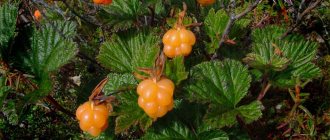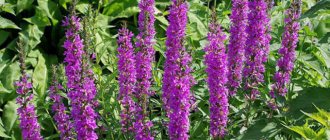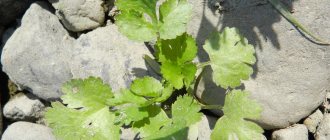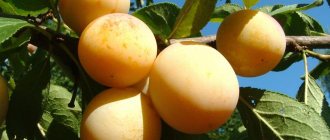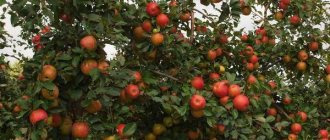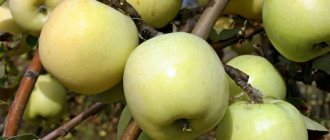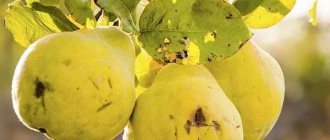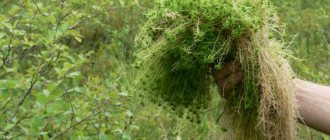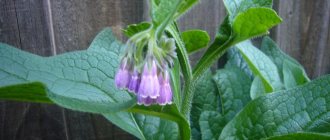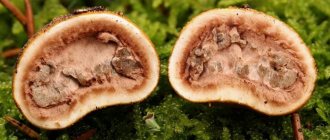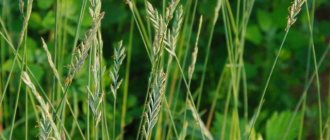We are looking for an answer to the question - are saffrons and marigolds different flowers?
Bright, unpretentious decorative marigolds and royal saffron are often “inhabitants” of flower beds in garden plots, and are a legendary spice plant. It would seem that they are different representatives of the flora, but why are they often confused with each other?
What is the value of both plants? How do they differ from each other and what do they have in common? Let's try to understand this article and at the same time find out why there is such confusion with their identification.
Comments (9)
Tamara
04/22/2018 at 12:04 pm |
For me, saffron is a hassle-free plant. I plant the bulbs in holes where I add a lot of manure so that it lasts for 5 years. I haven’t touched the saffron all these years. It doesn’t even require watering if August-September is rainy. I don’t complain about the harvest; I collect it as soon as the lilac flowers bloom. Every day, 50-100 pieces, for a whole week.Answer
Yulia Expert Plodogorod
06/21/2019 at 21:56 |
Hello Tamara! It’s good that you improve the soil composition when planting saffron. We would like to note that when using organics, you can only take those that are well rotted. Fresh organic products will only provoke burns and rotting of the rhizome. In addition, unfermented manure is useless for plants; they cannot process it.
Caring for such a plant is really not burdensome. We recommend adding to the described procedures the removal of weeds and periodic loosening of the soil. As for watering, the described approach fully meets the needs of the flower.
But we recommend monitoring the condition of the plants. If the weather is dry, and has been for a long time, and the flowers and leaves look limp, moisturizing is necessary.
The described amount of fertilizer applied during planting may not be enough, especially if the soil itself is not very fertile. For adult plants, it is better to use complex mineral mixtures, but avoid organic matter.
Even mineral fertilizers should be applied carefully. Excess nitrogen in their composition often provokes softening and rotting of the bulbs. The most important components are phosphorus and potassium. You can apply them before and after flowering. Potassium is useful in preparing the plant for winter.
We would like to note that to the listed care measures you should definitely add planting the bulbs every few years. After all, the mother plant will produce daughter plants. Without replanting, this will lead to dense plantings. This provokes a deterioration in flowering and the development of diseases.
Answer
Regina
04/23/2018 at 11:29 |
I also replant saffron bulbs every 5 years. So she created an entire plantation, planting children that bloom only in the third year. But I only bought 10 large bulbs, and they were quite expensive.
Answer
Yulia Expert Plodogorod
06/21/2019 at 22:29 |
Hello, Regina! Indeed, propagation by bulbs is the most effective way to make an entire plantation from a small number of flowers. Moreover, this technique allows you to preserve all varietal characteristics.
There are quite a few types of such plants. Depending on the specific variety, from one to ten daughter bulbs can be formed during the year. Therefore, we recommend that you clarify what type of saffron grows in your garden and set replanting dates accordingly.
But, regardless of the species, within three years so many “babies” are usually formed that they begin to interfere with each other’s normal development. Therefore, we recommend that you arrange seating a little more often. This will ensure your crocuses bloom better and also protect them from diseases.
The optimal time for such a procedure is summer. When the leaves of the plant turn completely yellow, you can begin replanting. We recommend sorting through the material removed from the soil in order to plant only healthy and undamaged promising bulbs.
The planting material chosen for propagation should be slightly dried and left in a room with good ventilation at a temperature of 18-20 degrees.
Those plants of the described species that bloom in spring should be planted in the soil in September. Saffron, which begins to bloom in autumn, is planted at the end of summer.
The recommended planting depth is 3-5 centimeters. The distance between flowers is at least three centimeters.
Answer
Nick
05/14/2018 at 10:48 |
Well, in the photo there are Tagethys flowers. Ugh!
Answer
Yulia Expert Plodogorod
06/21/2019 at 22:47 |
Hello Nick! The photos presented in the article show the flowering of saffron. Let's take a closer look at the botanical description of the buds to make sure of this.
During flowering, the saffron plant looks like half-open elongated buds that reach a length of 7-8 centimeters. Single flowers. Up to 3 buds can appear from one bulb, which are covered with membranous scales.
The perianths are collar-shaped. The bends of the corolla are six-lobed, turning into a tube with a cylindrical shape. The stamens are not long, attached to the throat. Anthers linear, slightly higher than stamens. The color of saffron buds is quite varied.
We would like to note that there are quite a lot of varieties of saffron. Crocus Coupe, Superior, Kashmiri, Iranian are found.
In addition to those described, there is also Imeretian or false saffron. This spice is made from ground marigold flower baskets. Perhaps this is why confusion arose, although this plant is not described or illustrated in the article.
Answer
Oleg
06/11/2018 at 12:11 |
I tried to try growing saffron, first at home in a pot, then in the country. It didn’t turn out very well, most likely the problem was with the quality of the bulbs that were sold to me. In general, only the plants at the dacha came to flowering, and even then I missed the moment of collection.
Answer
Yulia Expert Plodogorod
06/21/2019 at 23:38 |
Hello, Oleg! There are several nuances when growing the described plant in a pot. First of all, not all varieties are suitable for such cultivation. Some produce small and inconspicuous buds in indoor conditions; for other varieties it is very difficult to create suitable conditions.
We recommend choosing one of the large-flowered Dutch hybrids for growing at home. Suitable, for example, are Lilac Remembrance and Blue Vangart. The best quality planting material can be purchased in August and September. Those specimens with a bulb diameter of at least 5 centimeters grow best.
After purchasing the bulbs, they should be kept at a temperature of 20-24 degrees for about 1-2 weeks for adaptation. The storage room is chosen to be dry and well ventilated. After this, the bulbs are removed for storage. The optimal temperature is 5-9 degrees.
It is worth deciding when you need to get flowering plants. The date of planting the bulbs in the ground depends on this. Usually, you need to plant 3 months before the expected flowering.
Bowls are used for planting. The soil should be light, drained and moist. For plants that are later used as indoor flowers, the soil must also be nutritious. Acidity is preferably neutral. Both between the bulbs and from the edge of the container it is worth maintaining a distance of 2.5-3 centimeters.
After planting is completed, the plant is again transferred to a cool room. The rooting process takes about 2-2.5 months. No care is required at this time. Unless the substrate gets very dry, you can lightly water the plants.
When the first sprouts appear, the crocuses are transferred to a room with a temperature of 12-15 degrees. Now you need to provide the seedlings with abundant lighting. We would like to note that a higher temperature will accelerate the withering of the buds, and a lack of light will make the shoots elongated and pale, and the flowers will lose their decorative effect.
Crocuses should be watered sparingly; this flower does not tolerate waterlogging or stagnation of moisture. For the same reason, it is worth making drainage holes in a timely manner.
The buds appear approximately two weeks after the sprouts appear. The flowering period lasts about 10-15 days. After care, do not change until the leaves are completely dry. After this, the bulbs are removed, dried and stored again.
Answer
Alexander
11/19/2020 at 5:48 pm |
Good afternoon How to contact you? Interested in advice on growing saffron?
Answer
From the Astrov family
Flowers Marigolds are annual and less often perennial plants of the Asteraceae or Asteraceae family, native to America.
They came to Europe and Asia in the 16th century thanks to sailors. The plant has an erect branched stem, grows in the form of a bush 20-120 cm high, the leaves are pinnately dissected, the inflorescences are baskets, the color of which varies from yellow to brown, the fruit is a black or black-brown, flattened achene. Marigolds love light, warmth and water and bloom continuously from spring to autumn. The beneficial qualities of marigolds are widely used in pharmacopoeia and folk medicine. The flowers serve as raw materials for the production of dietary supplements and antiviral drugs; the water decoction is used by traditional healers as a diuretic, anthelmintic, and for the treatment of diseases of the upper respiratory tract, mouth and gums.
Marigolds contain:
- essential oils;
- phytoncides;
- folic acid;
- ascorbic acid;
- routine;
- flavonoids;
- lutein;
- linalool;
- ocimene;
- terpinene;
- alkaloids;
- ketone;
- fat-soluble vitamins A and E;
- magnesium;
- calcium;
- iron;
- phosphorus;
- potassium;
- selenium;
- copper;
- zinc;
- gold.
You will find all the details about the medicinal properties of marigolds and contraindications for their use in this article, and read about how this plant is used in folk medicine here.
Imereti variety
Imereti saffron is a very heat-loving plant with an erect, branched, heavily leafy stem up to 50 cm in height. The leaves are finely dissected, from 6 to 11 cm long. Inflorescences of bright yellow tongues appear in early July. The fruit of Imeretian saffron is a dark brown small two-seeded seed .
Whole marigold flowers are used to make this spice. They are dried and crushed, after which they are added as a seasoning to kharcho, satsivi, chakhokhbili, vegetable and fish dishes, sauces, wine and other national dishes. The smell of Imeretian saffron has pronounced fruity notes.
You can learn more about the production and use of this spice from the video:
If you are breeding and growing marigolds in open ground or at home, then perhaps our articles about this wonderful plant may be useful to you. We suggest reading materials on the following topics:
- Upright, deviated and thin-leaved types of marigolds.
- Description of low-growing varieties.
- Types and varieties of perennial and annual marigolds.
- Features of growing marigolds from seeds.
- How to properly care for and what to feed for abundant flowering?
- How and when to plant in open ground?
- Features of growing marigolds in pots or boxes at home.
From the Iris family
Saffron is a bulbous, stemless perennial of the iris family , or crocus (Crocus sativus). The plant is a corm, low-growing (up to 25 cm tall), with basal linear leaves and single flowers, the fruits are three-locular capsules, the seeds are small and angular. Blooms in spring and autumn. It is grown both as a garden and as an ornamental potted plant.
Saffron as a spice is the dried ground stigmas of the crocus flower. In appearance, these are thin red-orange tubes 2-4 mm long, three in each flower, with a pungent, sweet, subtle and spicy aroma. They are separated from the flower, dried for half an hour in a dryer, and stored for no more than two years.
The stigmas are collected early in the morning, before the sun begins to get hot. To get 1 kg of saffron, you have to process about 220,000 newly opened flowers before they wither. And each blooms for only 1-2 days. The process of harvesting saffron involves a huge number of people .
Since ancient times, saffron has been worth its weight in gold. A kilogram of saffron costs up to 6 thousand dollars today. The most expensive saffron is Spanish, the cheapest is Iranian. But the fabulous cost of this spice, even of Iranian origin, is explained not only by the complexity of processing. The effect of saffron on the human body is phenomenal.
Saffron infusion:
- relieves pain;
- calms;
- strengthens vision;
- regulates cardiac activity;
- promotes rejuvenation of the body by stimulating cell division;
- expels intestinal polyps;
- removes kidney stones;
- cleanses the blood;
- relaxes smooth muscles;
- destroys harmful bacteria;
- prevents seizures;
- treats inflammation;
- lowers cholesterol levels;
- in small doses tones the nervous system;
- increases libido;
- regulates the cycle in women.
Constant use of saffron in small quantities rejuvenates and cleanses the body, drives out diseases, strengthens the spirit, and relieves depression. Fabric dyed with saffron repels parasites and protects against infections, and the sunny yellow dye does not wash off for centuries. Rinsing your hair with saffron not only gives it a bright golden hue, but also eliminates dandruff, dermatitis, hair loss and split ends. Products and dishes to which saffron is added do not spoil for a long time. Our ancestors knew all this many thousands of years ago.
Not so long ago, the anti-carcinogenic properties of saffron were discovered. The extract of this flower formed the basis of anti-cancer drugs. Saffron contains :
- essential oil (pyrocrocin glycoside);
- fatty oil;
- carotenoids;
- flavonoids;
- lycopene;
- thiamine;
- wax;
- B vitamins;
- nitrogenous substances;
- potassium;
- calcium;
- phosphorus.
The norm for saffron consumption for a person is one gram per year . How to calculate this? For example, for three liters of fresh milk, just one stigma of saffron is enough to instantly color the milk bright yellow, give it a unique aroma, saturate it with healing elements and feed several people with it.
But one gram of saffron contains up to seven hundred stigmas, and it is not necessary to use saffron daily. And if you eat three grams in one sitting, you can get sick, because moderation is necessary in everything. Moreover, too much spice is tasteless.
Here you can see photos of these flowers.
Recipes
When using saffron in traditional medicine recipes, it is extremely important to follow the recommended proportions, dosage and administration.
Attention! If after taking saffron you experience headache, dizziness, nausea, diarrhea, rash and other unpleasant symptoms, use should be stopped immediately - perhaps this is an individual intolerance to the spice.
Tea
Tea with the addition of saffron can be drunk for respiratory diseases, digestive, nervous and cardiovascular disorders, disorders of the genitourinary and immune systems.
Brew two teaspoons of good black tea in 0.5 liters of water, throw 3-5 threads of saffron into a glass, pour tea to the brim, leave for 15 minutes. Drink a glass no more than three times a day.
Improves the functioning of the gastrointestinal tract, strengthens the immune system
Milk with saffron
Saffron gives milk a pleasant golden hue and saturates it with useful substances.
Take 250 ml of milk, ¼ teaspoon of spice (about 5 stigmas), a teaspoon of honey and, if desired, 0.5 teaspoon of butter. Bring the milk to a boil three times, remove from heat, add saffron, honey and butter, mix well. Pour from one cup to another several times to saturate with oxygen; it is best to drink at night.
Calms the nervous system
Cabbage
This is a very tasty and healthy dish of Korean cuisine, which is perfect for dietary nutrition. For the recipe you will need the following ingredients:
- cabbage – 0.5 heads;
- onion – 1 pc.;
- garlic – 2 cloves;
- sugar – 2 tbsp;
- vegetable oil – 2 tbsp;
- vinegar – 1 tbsp;
- saffron – 1 tbsp;
- cilantro and coriander - 0.5 tsp each;
- red and black pepper, salt to taste.
Wash the cabbage well, remove the outer damaged leaves, chop coarsely, pour boiling water so that it covers the pieces, leave for 10 minutes and drain the water. Separately, boil a liter of water, dissolve sugar, add saffron, salt and other spices, garlic, vinegar. Peel the onion, cut into small cubes, fry and throw in water with spices, boil a little over low heat. Pour the resulting marinade over the cabbage, cool slightly and refrigerate for a day.
What's the difference?
The main difference is that they belong to different plant families . The effect on the human body is also significantly different: saffron has rejuvenating and healing properties in general, marigolds affect individual systems of the body.
However, other plants are often suggested as saffron substitutes. These include Indian turmeric, Mexican safflower, the widespread calendula (“poor man’s saffron”), a mixture of “curry” spices and Imeretian saffron, which is loved in the Caucasus and especially in Georgia. It is most often confused with saffron.
Harm of saffron
For a whole year, a person can eat no more than 1 gram of seasoning. Otherwise, the product can cause severe poisoning or death. Therefore, you should add saffron to your dishes in small portions so as not to harm your body.
It is contraindicated in diabetes mellitus, chronic cardiovascular diseases and peptic ulcers of the intestines and stomach. Pregnant women should not use it either, as the seasoning can cause uterine tone and cause miscarriage. Children under 3 years old should also not be given saffron.
Why is one thing mistaken for another?
- The first reason for confusion and identification between marigold and saffron is the color and aroma associated with both plants. The bright orange powder extracted from the stigmas of the seed crocus and ground marigolds look the same at first glance and have a rich, specific spicy odor.
Only a specialist who has been dealing with spices for several years can distinguish the difference. One stamen of saffron sativum turns three liters of pure water or milk orange and instantly spreads a sweetish aroma, but the sweetness is not felt in the taste. Other spices similar to saffron behave differently.
The second reason for confusion is the medicinal effects of saffron and marigolds. Despite the fact that plants belong to different botanical families and their different types of influence on the body, there are similarities in the area of influence: nervous system, vision, digestive organs, antibacterial and anti-inflammatory effect.
At the same time, wild saffron is not an analogue of seed saffron, moreover, it is easy to confuse it with the deadly poisonous colchicum.
What is saffron and what does it look like?
The product is the stigmas of the inflorescences of a plant called Crocus sativus. Outwardly, it looks like small strings tangled together; less often the spice is sold in powder form. It has a unique taste, aroma and chemical composition that cannot be compared with any other spice in the world.
Interesting! Saffron can easily be called one of the most ancient products in the world - it is mentioned in Egyptian papyri, the works of Homer and Hippocrates, and even in the Bible along with olives and figs.
Where and how does it grow
In the wild, seed crocus is found in regions with cold winters and hot summers - Iran, India, Afghanistan, Turkey, Azerbaijan, but recently it has begun to be cultivated in Spain and France.
Saffron plantation in Spain
It takes root well in lighted places with fertile, well-drained and breathable soil - the flower is a drought-resistant plant, so an excess of moisture is detrimental to it. Under favorable conditions, crocuses bloom in the second year after planting and grow in one place for several years, but the inflorescences become smaller over time and look less aesthetically pleasing.
Photo of the plant
Saffron color
The color of the threads used as a spice is a rich reddish-orange or bright orange.
Saffron color is bright red/orange
Crocus flowers
There are about 30 varieties of crocus that bloom in spring or fall, depending on the variety. The flowers look like a glass with six petals of different colors - the most common are white, lilac, yellow, purple and pink petals, a mixture of shades is possible.
When the crocus blooms, it resembles a star or bowl with bright orange pistils in the middle.
Crocus flower
For reference! Crocus flowers have many varieties of different shades - only pure red inflorescences are not found in nature.
Smell and taste
Saffron has an intense, spicy, slightly intoxicating aroma and a specific taste, which experts describe as tart, slightly hot, with a slight hint of sweetness.
Comparative description and photo
There is a debate among flower growers about the fact that marigolds are a more affordable, but equivalent in appearance and properties, analogue of saffron. Both of these plants are widely used in cooking, medicine and cosmetology (read about the use of marigolds in folk medicine and cooking here, and we talked about the medicinal properties and contraindications to the use of this flower in this material). But at the same time, marigolds and saffron are far from related, but different flowers , but they have similar qualities. A comparative description of them will help you see the difference.
Plant from the Asteraceae family
Marigolds belong to the Astrov family and are an annual crop.
Perennial varieties of these flowers are very rare. Marigolds are popularly known as Chernobyvtsy. Botanical description :
- They have a bush shape and are small in size.
- The stem of the plant is erect and branched.
- Inflorescences in the form of baskets.
- The flowers are bright, often yellow and orange, with double edges.
- The fruits of marigolds are flattened black achenes.
Marigolds are a light-loving plant that loves warmth and moisture. The flowering period begins in late spring and continues until autumn (you can see what the flowers look like in the photo, and also find out why they do not want to open buds here, and in this article read about how to feed marigolds for abundant flowering).
In summer cottages, marigolds also bring benefits : they are used as natural insecticides. Flowers repel and protect plants from nematodes, weevils, onion flies, cutworms, aphids, and ants. That is why agronomists recommend planting marigolds between vegetable beds, along the perimeter of the beds, or in the form of small islands. You can learn more about these colors from the video:
Flowers from the Iris family
Saffron is a perennial plant from the Iris family. Excerpts from the botanical description :
- It has tubers in the form of bulbs.
- It grows to a small height - up to 25-30 cm.
- It has no stem.
- The leaves are basal linear, the buds are solitary.
- The fruits are small seed pods.
- Saffron has two flowering periods - autumn and spring (depending on the specific variety).
The stigmas of the flower externally resemble tubes no more than 4 mm long, which have a sweet, pungent aroma. There are 3 such tubes in one flower. The world-famous spice is prepared from them. To prepare it, the tubes are carefully separated from the flower, dried and ground. This spice can be stored for no more than 2 years.
Saffron is high in calories, contains a large amount of vitamins and beneficial minerals (thiamine, fatty oil, nitrogenous substances, lycopene and others). The flower also has medicinal properties and is widely used in medicine .
The plant has anticonvulsant and anti-inflammatory effects, reduces cholesterol. Crocetic acid contained in saffron not only prevents the growth of cancerous tumors, but also destroys their stem cells. Externally, the flower is used to treat burns and skin diseases.
Types of saffron
Depending on the area where it is grown, there are different quality characteristics of saffron.
The following types are considered the most popular:
- Kashmiri. This spice is grown in the region of Kashmir and Himachal Pradesh (India). It has a rich dark ruby color and a pronounced aroma. There are three varieties of this spice: Shahi, Mogra, Lachha. Due to the small volume of production it has the highest cost
.
- Spanish . Grown in Valencia and La Mancha (Spain). There are 2 grades: Coupe and Superior. The first of these has an incredible aroma and is the most prized, but the second is more widespread.
- Iranian . Grown in the territory of Razavi Khorasan. It has good color properties and is more affordable at $460.
- Greek . Grows in Kozani. Complies with all environmental requirements and quality standards. Its price is about $800 per 1 kg.
The described plant crop grows well in areas with a warm and dry climate. For this reason, it is also grown in eastern countries - Turkey, Tunisia, Azerbaijan, Pakistan, China, Japan, as well as in Mexico, New Zealand, etc. Now they have started growing it on a small scale even in Switzerland. T
Did you know? About 90% of saffron is grown in Iran and most of it is exported. There it is called “red gold”.
Turkish and Tunisian saffron can be found on sale, but you should be careful - often in the markets safflower, better known as American saffron, is passed off as the desired spice. It is used as a substitute, but it is inferior to the original in many respects.
In 2014, the cost of 1 kg of this spice was about $2,000: such a high cost was due to the complexity of preparation - 1 flower produces approximately 3 stigmas, and for 1 kg of saffron it is necessary to collect 100-200 thousand flowers by hand. This plant blooms en masse for about two weeks, and the buds last no more than 3 days.
The so-called Imeretian saffron is made from another plant - marigolds, does not have the luxurious aroma of natural spice and is much cheaper. These substitutes are also good at turning dishes yellow or orange and are good to eat, but not as highly prized.
Important! When purchasing, be sure to evaluate the appearance and strong saffron smell of this spice. In addition, it should be remembered that real spice cannot be cheap, and it is better to buy it whole, rather than ground.
What is the difference?
Comparative characteristics of plants.
| Index | Marigold | Saffron |
| Family | Asteraceae | Iris |
| Stem | Branched, straight | Absent |
| Root | Branched, there are adventitious processes | Onion-shaped |
| Motherland | America | India, Middle East |
| Impact on the body (is both different and similar). | Benefits for individual organs and systems. | Rejuvenating and general healing effect. |
| Use in cooking | Included in herbal preparations. | The most expensive spice. Doesn't mix well with other spices. |
Medicinal properties of saffron. How is the plant useful? Traditional medicine recipes
The beneficial properties of saffron are explained by the fact that the plant contains vitamins, minerals, oils, etc. It is included in more than 300 medications, mainly manufactured in Asian countries, and is used for headaches, insomnia, etc.
Tinctures containing saffron are used to treat severe coughs, bronchitis and colds. It is used as an external remedy to treat burns and skin diseases. It is used to prepare eye drops as a treatment for cataracts.
The plant is included in many cosmetic products: this cream nourishes skin cells, improves its appearance, slows down the aging process, etc.
Milk with a pinch of saffron is used as a medicinal drink (for the treatment of chest pain and bronchitis). Medicinal tea with spice strengthens internal organs and the nervous system. Recipe for making tea with saffron: add a pinch of seasoning to 0.5 liters of boiling water. Drink 1 glass of infusion half an hour before meals (no more than 3 times a day).
Self-medication is prohibited. If you want to use saffron systematically as a remedy, it is better to consult a specialist. A herbalist can prescribe a comprehensive treatment after passing the necessary tests. Treatment may include both tinctures/decoctions from the plant itself and medications containing it.
Imeretian variety
Another name is zafaran. Belongs to the Asteraceae family. An annual herbaceous plant. According to the botanical description, Imeretian saffron is almost identical to marigold :
- The stem is erect, up to 50 cm high.
- Leaves up to 11 cm long, finely dissected.
- Inflorescences appear in mid-summer.
Decorative saffron
Let's look at a few more decorative varieties:
Let's look at a few more decorative varieties; for convenience, we indicate them in the table.
| Variety name | Description and features |
| Crocus Susiatsky | The diameter of the perianth is 4 centimeters. Peduncle up to 10 centimeters high. Bloom purple or yellow. The flowering period occurs at the beginning of April |
| Saffron Heuffeliana | Stem height up to twenty centimeters. Shade of buds: lilac, violet or white. Blooms in March-April |
| Saffron Yellow | Peduncle six centimeters high. The color is orange, golden, there are purple stripes. Flowering occurs in April |
Reason for confusion
Many gardeners believe that marigolds and saffron are the same plant, but this opinion is wrong, since these flowers are completely different, although they look very similar to each other. Why are marigolds and saffron often confused? There are several reasons for the confusion :
- Visual similarity of color and aroma.
- Beneficial features. Both marigolds and saffron are equally useful for treating the human nervous system, gastrointestinal diseases, and improving the nervous system. In addition, both plants are used to treat bacterial infections and inflammatory processes.
So, the main difference between marigolds and saffron is that they belong to different families. They contain vitamins and microelements that affect various organs of the human body. And confusion arises due to the similarity of the aroma and color of these plants.
If you find an error, please select a piece of text and press Ctrl+Enter.
Where, when and how to plant saffron crocus
Saffron flower photo
How to grow saffron in the country? Crocus saffron or simply saffron prefers:
Light. The sunniest place in the garden is what it needs. Spices need the sun to add flavor and color.
Drainage. This is a prerequisite for growing autumn crocus. The plant does not tolerate stagnant moisture. It also does not respond to temporary dry soil.
Moderate watering. In autumn, the air temperature is not very high, so frequent watering should be avoided. The plant only needs one good moisture every seven days.
The soil around the plant should not be wet. Between waterings it should dry out a little, but not become too dry.
Fertile, permeable soil. Crocus sativa grows better on light soils than on clay soils. When creating soil for planting, you must add clean, clay-free sand.
To grow saffron:
It is necessary to calculate the required amount of planting material. Saffron is a very economical spice. Three stigmas are enough for any dish.
The number of bulbs depends on how many dishes a family prepares using saffron per year. As a test planting, it is enough to purchase 10 bulbs.
Purchase planting material. It is best to purchase bulbs from a reputable garden center. With this method, the grower sees what he is buying and can select bulbs without signs of disease or damage.
Buying online is also a good option if the store specializes in selling branded planting material. But in this case, all efforts can be reduced to zero by the poor performance of the delivery organization. Bulbs are quite easy to dry out or damage during transportation.
Prepare the place. You need to add sand and a little humus to the garden soil. Heavily fertilized soil will cause the flower to gain green mass to the detriment of flowering. After this, all ingredients must be thoroughly mixed and loosened.
Lat. Crocus sativus
A bed is dug to a depth of 10 cm. Fine crushed stone or expanded clay is poured onto its bottom in a layer of 3-5 cm. The soil mixture is poured on top. The bulbs must be at a depth of at least 5 cm from the surface of the earth.
Plant the bulbs. Planting takes place in May in well-warmed soil. Crocus bulbs are carefully placed in the groove with the bottom down and the sprouts up.
The top of the planting is covered with the remaining soil. There is no need to compact the soil. The main thing is that the bottom of the bulb is in good contact with the soil.
After this, the soil can be slightly moistened with warm water with the addition of potassium permanganate until it turns a soft pink color.
Collect flowers on time. This is one of the most important and delicate stages.
It is for this moment that saffron crocus is grown.
Proper preparation and landing is 30% of success. The rest depends on good planting material and proper care.
Saffron (photo of flowers)
Currently, more than 250 varieties of saffron (or crocus) are known. All these varieties are divided into those that bloom in spring or autumn. Moreover, in the spring they begin to bloom earlier than all other flowers, immediately after the snow melts, and in the fall they are the last flowering plants. This bulbous perennial belongs to the iris family; natural places of growth are European countries and Central Asian regions.
Saffron in the ground
These flowers are very beautiful and grow in open ground, but only one variety is the basis for the preparation of saffron, which is widely used in cooking.
This name characterizes the color of the seasoning - bright yellow, and translated from Arabic, saffron (or “zafran”) means “to be yellow.”
Like other bulbous flowers, crocus can be forced indoors, in which case flowers can be obtained at any time of the year. Saffron flowers and their photos are very popular among the population of many countries - they are elegant, pleasing to the eye when other flowering plants are just beginning to emerge from the ground.
How and how long is saffron stored?
Saffron should be stored in an airtight container. How much and how long the seasoning will be stored depends on the environmental conditions. The place for it should be chosen dark and dry, where the temperature does not exceed +20°C. Under such conditions, its shelf life will be, like most spices, 2 years. You can determine if a product is not expired or of high quality by its strong odor, which seeps even through the container.
Saffron is an expensive and luxurious spice that gives dishes an exquisite aroma and taste, coloring them orange. It has medicinal properties. Due to its high cost, you can often find fakes of this spice on sale. It can be grown from corms yourself, but only under favorable conditions.
Origin
For the first time, mentions of this perennial herb are found in manuscripts of the countries of the East, in Egypt and Mesopotamia in the 1st - 2nd millennia BC. Its medicinal properties were known to the people of these countries even then, and crocus was used in Chinese folk medicine even earlier - around 2500 BC.
Saffron plantation
Traditional healers claimed that products based on it give a person strength and also stimulate male sexual abilities. Over time, traveling traders brought this spice to the Middle East and European countries. This approximately happened in the 9th – 10th centuries AD.
Among Europeans, Spain was the first to cultivate this spicy crop on a large scale. Then the Italians and French began breeding it.
Homeland of saffron
Saffron, used as a spice, is not found in the wild. And Asian countries are considered its historical homeland . Having appreciated the taste of this seasoning, saffron is now grown in many countries of the European continent, Iran and Pakistan, as well as in Crimea and Japan.
The best quality saffron grows on Spanish plantations. Only the stigmas are used as a seasoning for these flowers.
Saffron oil
Benefits, properties, application
Oil from crocus stamens is not used in its pure form. It is used only as an additional ingredient, added to creams, masks and shampoos, both for the body and face. The ingredients in the oil have the following positive effects:
- rejuvenation, moisturizing and toning;
- getting rid of age spots and improving complexion in general;
- anti-inflammatory and wound-healing effect;
- aromatherapy.
When using hair oil, hair generally strengthens and grows, it becomes soft and shiny. This is evidenced by numerous reviews of women who used healing oil.
Name
The flower got its name “saffron” for its main color. And the second “name” is associated with the Greek legend about a charming young man - Crocus. The Greek god of trade, Hermes, fell in love with him, but did not achieve reciprocity. As a result, this young man accidentally died at the hands of this ancient god, and at the site of his death, previously unknown flowers grew, which were named “crocuses” in honor of this young man.
Crocus
Saffron for weight loss
Saffron plays a big role in maintaining women's health and beauty
Saffron plays a special role for women. It helps relieve pain during menstrual periods and strengthen the female body, helps normalize hormonal levels, etc. Pregnant women or those with genital diseases are prohibited from using the seasoning.
One of the beneficial properties of the plant is its ability to suppress appetite, i.e. a person eating food with this seasoning quickly becomes full. Thus, there is a gradual reduction in portions without significant changes in diet. A person loses excess weight, while his health improves.
Description
This is a perennial herbaceous bulbous flower with narrow foliage growing directly from the bulb. Tubular-shaped flowers also emerge from there. Scales are visible on the underside of saffron stems and leaves; they are transparent and thin. The flowers are unisexual, the perianth is six-parted in the shape of a brightly colored corolla.
Structure of a crocus
The stigma and stamens (usually 3 pieces) are hidden inside the bud. The color of the stamens is bright, can be yellow, orange or red. The ovary, from which the fruit is subsequently formed, first grows under the ground, the ripening fruit is pushed out, where it ripens. If the seeds are not collected on time, the ripe fruit opens and the seeds spill out onto the ground. Flowers are pollinated by flying insects - bees, wasps.
Crocus buds are very similar in shape to tulips, only smaller in size. Their color can be yellow or blue. There are varieties with white buds.
The bulbs of these perennials are actively used for food, which are boiled, baked, or used in the preparation of other dishes. However, the most valuable thing in saffron is their stigmas with stamens - the “queen” of all seasonings is prepared from them. Yellow dyes and medicines are also prepared from them. The spice made from stigmas and stamens is the most expensive, but it is also often counterfeited.
Growing saffron
Saffron is created in several stages:
Planting a bulb. Crocus sativus bulbs are used for this purpose. The autumn crocus, which is very poisonous, is similar to it.
Stigmas help distinguish plants. The saffron crocus has fewer of them, only three. But his rival boasts of six red stigmas.
Growing. When planted in spring, the plants remain dormant throughout the summer. At this time, they accumulate strength to bloom their precious flowers. The buds appear immediately along with the leaves.
Collection. This is the most important stage in preparing the “golden spice,” as saffron is still called throughout the world. The three precious stigmas must be removed from the flower on the very day it blooms. If you miss the moment, the stigmas, like the flower, will fade.
To collect the stigmas, the flower is cut off or pinched off from the plant. It should not be pulled out with the onion. After harvesting, the bulb remains in the ground or is dug up for winter storage. Using forceps, miniature scissors or sensitive thin fingers, the stigmas are removed from the flower and placed in a separate container.
Drying. The mode of drying the stigmas is no less important. This process must be carried out in a warm, ventilated area, excluding direct sunlight.
Storage. It is recommended to store saffron threads in a glass container that should not be exposed to light for a long time.
Each stage of growing saffron, carried out in compliance with the rules, will lead to the desired result in the form of an aromatic seasoning.
Beneficial features
Examining saffron stigmas, the following active substances were found in their composition:
- essential oils;
- Ca, P;
- glycosides;
- a number of vitamins;
- Crocin is a yellow dye.
The taste of this seasoning is spicy and slightly bitter, and has a pleasant aroma.
Saffron - the king of spices
The active substances that make up the stigmas have the following properties:
- restore the internal strength of the body after serious illnesses;
- remove toxins and harmful substances from the blood;
- restore appetite;
- help improve the functioning of the gastrointestinal tract and liver;
- relieve pain;
- contribute to the rapid maturation of abscesses;
- accelerates wound healing;
- used in gynecology to relieve pain during menstruation and restore the uterus after childbirth;
- restore male potency.
But you should only take any saffron-based medications after consulting your doctor.
Watch also the video on the topic:
Why saffron is the most expensive seasoning
This spice is really very expensive! For example, Spanish saffron has a price of about 15–20 thousand dollars per kilogram. The cost of Kashmiri saffron reaches 30 thousand dollars. Iranian saffron costs approximately $400–500 per kilogram. And this is perhaps the lowest price for this spice.
“Where do these prices come from?”
- you ask. The thing is that this spice is collected almost by hand. Machine assembly technologies are not suitable due to the fragility of the material being assembled and the value of maintaining its integrity. And from one hectare they get only ten kilograms of finished spices. It’s hard to disagree that this is a very costly and labor-intensive production. This also includes the benefits and nutritional qualities of the seasoning. The spice is unique. This is where this seemingly exorbitant price comes from.
Saffron: health benefits and harms
To understand how healthy a spice is, it is worth considering its composition and nutritional value.
The stigmas of the crocus plant contain a huge amount of useful substances. This is why saffron is valued.
The seasoning contains:
- vitamins of group B, C, A, PP;
- zinc, calcium, magnesium, sodium, fluorine, potassium and other minerals;
- essential oils.
100 grams of product contains: proteins - 11.44 grams; fat - 5.6 grams; carbohydrates - 61.2 grams. Energy value - 310 kcal per 100 grams.
Benefits of saffron
It is generally accepted that regular use of this spice promotes:
- improving the functioning of the digestive tract;
- cleansing the body of toxins;
- relaxation of the nervous system;
- strengthening the skin and increasing tissue elasticity;
- strengthening musculoskeletal structures in the body;
- stabilization of the hematopoietic system;
- blocking the development of pathogenic flora in the body;
- formation and strengthening of the immune system.
Using this spice, a huge number of folk remedies are made for the treatment and prevention of various diseases.
For example, saffron in combination with milk (herbal tea) and honey is used to dissolve kidney and gallstones. Various decoctions and infusions of saffron are used to cleanse and rejuvenate the body. Saffron-based products are used to treat diseases of the throat and upper respiratory tract. The seasoning actively prevents the development of viral, bacterial, and fungal infections. In folk medicine, there are a huge number of saffron-based recipes that are aimed at treating joints and muscle tissue. Saffron is included in various soothing mixtures. This seasoning relaxes the nervous system and promotes healthy sleep.
With the help of saffron you can relieve pain and relieve spasms. Therefore, this spice is included in the formulation of painkillers and antispasmodics. Saffron has an anti-inflammatory effect and stabilizes metabolism. Therefore, the spice is good for maintaining the health of the digestive system. Saffron is often included in endocrine preparations. This seasoning is used as a natural aphrodisiac to restore and maintain sexual function in men and women. Saffron is sometimes used to treat asthma and other allergic diseases.
However, no matter what medical purpose saffron is used for, you should not prescribe it yourself and use it without the supervision of a doctor. After all, any chronic diseases, as well as acute pathological conditions, can become a serious contraindication for the use of this spice.
Harm of saffron
Like any spice, saffron can be beneficial to the body, and in some cases, cause harm. After all, there are a number of contraindications for almost every product.
So, it is not recommended to use saffron in the following cases:
- pregnancy and breastfeeding;
- children under 3 years of age;
- diabetes mellitus type I, II (with caution);
- high blood pressure and hypertension in the acute stage;
- peptic ulcer of the intestines, stomach, duodenum.
In large quantities, saffron has a stimulating effect on the nervous system. You should not go beyond the recommended norms (it is permissible to consume up to 1 gram of saffron per year; it is permissible to use no more than 5 threads of seasoning per dish), even if you really like this seasoning and are available in unlimited quantities.
It is also not recommended to use this spice if you suffer from food allergies. Saffron should be used with caution by persons suffering from nervous and mental disorders and prone to negative reactions from the nervous system.
If you have any doubts related to the characteristics of the body or based on the current state of health, you should consult a specialist about the permissibility of eating saffron.
Map
How to distinguish real saffron from fake?!
- Proper saffron is the upper part (stigma) of the pistil of Crocus sativus flowers, painted in a dark purplish-red color. Each stigma is a tube opening upward with a serrated upper edge.
- The finished spice most often appears as tangled balls of stigmas 3-5 cm long, single or sitting in groups of three on a light yellow base. At the same time, the light lower part, which does not contain dye, should be no more than 1 cm. Typically, dry tubes are flattened, which is why they take on the appearance of a thread expanding towards one end, up to 1-2 mm thick. Saffron is most often sold in transparent sealed packages, but usually the characteristic bitter-spicy smell is felt through any packaging.
- The second type of saffron is fragments and small parts of stigmas, which are sold in sachets, boxes and bags. It loses to the first grade only because the spice loses its attractive presentation, and grinding is associated with a partial loss of essential oil.
- The third variety is ground saffron. All small parts are used for grinding, even the yellow unpainted legs and dust.
- Everything is counterfeited - both the whole saffron and the packaging. Often any saffron is passed off as “La Mancha saffron.” Cotton threads, cut plastic, cut dry petals of other plants - poppy, pomegranate, even leek roots, etc. are used. The most common counterfeits are turmeric powder and safflower flowers labeled “saffron.”
- It is even easier to counterfeit ground saffron - it is sold too wet to increase weight, diluted with salt, starch, various chemical dyes from ground paprika and sandalwood to brick dust - everything goes into use.
- So you need to buy saffron only in the most trusted places and from trusted manufacturers.
- treatment of oncological diseases (even in the late stages of the disease it has an antitumor effect and blocks the growth of cancer cells);
- blood purification (renews and cleanses the blood, which means strengthens the cardiovascular system, nourishes all cells of the body);
- improvement of brain activity (growth of brain tissue, improvement of memory);
- cure neuroses;
- relieving headaches and insomnia;
- regulation of gastrointestinal function;
- getting rid of excess bile;
- cleansing the kidneys and bladder (saffron with honey helps break up stones in the kidneys and bladder);
- antioxidant effect (improving energy metabolism, destroying harmful substances);
- tonic effect;
- restoration of vision, treatment of the retina;
- improved erection;
- pain relief during menstrual periods;
- treatment of burns and tumors;
- getting rid of allergies;
- alcohol addiction treatment;
- carminative and antispasmodic effect;
- rejuvenation of the entire body as a whole;
- decreasing the level of radiation in the body.
P, S.: So, conclusions have been made, the benefits and possible counterfeits of saffron have been studied, and now you and I can consciously approach the purchase and future use of this wonderful spice! Good luck everyone!
Labels: Indian cooking
| Like: |
Saffron in cooking
Saffron is one of the most popular spices in the world, which is loved by famous chefs, including it in a wide variety of food and drink recipes.
What is it used for?
The spice gives dishes a pleasant golden hue, a spicy aroma and a specific bitter-spicy taste. When using saffron, it is important to observe moderation - 3-5 threads are enough to prepare the perfect dish.
Where do they add
You can add spice to any dish, from soups and sauces to any desserts. Saffron goes especially well with baked goods, salads, rice and meat - it is an essential ingredient in real oriental pilaf. It can be used alone or in combination with basil, thyme, rosemary and cinnamon.
What to replace
It is impossible to find a substitute for real saffron, but Indian turmeric has a similar bitter-pungent taste and also colors dishes in a pleasant golden hue . Its taste and aroma are not so rich, but there are also plenty of beneficial properties.
How to store
To store the product, you need to take an airtight container and place it in a dark place, the temperature no higher than 20 degrees. The shelf life is about two years - the spice cannot be used after it has lost its bright aroma.
Best stored in a glass or ceramic jar
For reference! You can distinguish real saffron from fake saffron using a simple test - throw a thread into a glass of water, which should turn orange. If the color of the liquid is yellow, the spice is fake.
In cosmetology
Saffron is an effective remedy for combating signs of aging, eliminating skin and hair problems. For cosmetic purposes, it can be taken orally or used to prepare masks and creams.
Cream
Face cream containing saffron can be purchased in stores offering Indian and Ayurvedic cosmetics, or you can prepare it yourself.
To do this, you need to take a baby cream or any nourishing cream (preferably made from natural ingredients) and add a few drops of saffron oil to it.
This product evens out the complexion, makes it fresh and even, eliminates rashes, fine wrinkles and other problems.
Iranian cream (Safron seed nutrient cream)
Oil
Saffron oil is obtained from the spice threads by steam distillation or extraction using special solvents. It has a rich hue and a very intense spicy aroma; in cosmetology it is used independently or as part of masks and creams.
Can be prepared at home
It is quite expensive, so you can prepare an analogue at home - grind a teaspoon of stigmas well, mix with 0.5 cups of olive oil. Leave for 12 hours, store in a dark place.
In medicine
Medicines prepared from saffron have a quick effect and have virtually no contraindications or side effects. When used correctly, they cope well with any disease, increase immunity and improve overall well-being.
Selection of crocus corms.
When purchasing crocus bulbs, first decide on the variety: spring-blooming or fall-blooming. The most popular crocuses that bloom in spring are Tamazini, Golden and Spring. Among those that bloom in autumn, the varieties Khoroshenky and Banatsky are most often bought, as well as the tall crocus Beautiful.
Crocus bulbs should be carefully examined when purchasing; they should be healthy and without damage. You should not buy bulbs that have begun to grow; when they bloom before planting, they lose their vigor. The diameter of an adult crocus bulb is approximately 4 cm.
